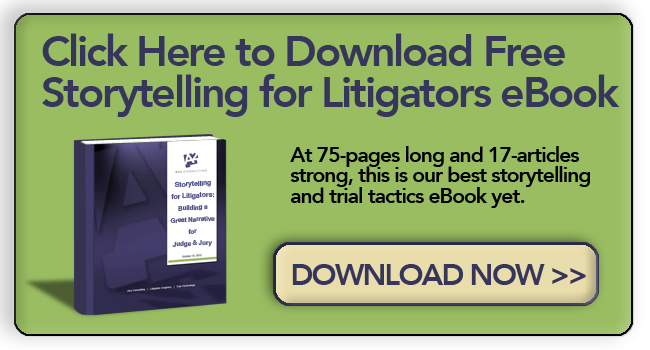I notice something about audiences in the PowerPoint presentation era. They seem to get easily disengaged part of the way into a presentation. This tendency is especially problematic in a courtroom setting since judge and juror visual attention is critical for courtroom persuasion.
We've all seen this before whether at trial or elsewhere. An audience member will start out sitting up straight and smiling, and then, after some time passes, they are looking at you, but you know there's some other unrelated processing going on behind the stare (i.e. family issues, work challenges or what's for lunch). This behavior occurs in all types of presentations whether a trial presentation, a board meeting presentation or a sales presentation.
To cope with drifting off, consultants have long encouraged presenters to put their important material at the beginning and at the end of presentations when audience attention is at its highest. That suggestion has always bothered me, since at trial, we really need our jurors to stay with us the whole time. But how can this be achieved?
I've noticed a peppering of articles and research on the topic of surprise over the years. Some researchers connect surprise with attention and persuasion. It's common sense that surprise would create attention, but it's less obvious how visual surprise would support persuasion. Let's look at some examples.
I wrote in 2012 about a study involving font choice. The study concluded that by choosing a hard-to-read font, one could force an audience member to stop, pay attention, read carefully what was written and overcome a natural human behavior called confirmation bias. Confirmation bias is the tendency of people to make up their mind about something, such as about a case during opening statements, and then only really listen to subsequently provided information that supports their predetermined conclusion. Choosing a difficult-to-read font is a form of surprise that forces the viewer to drift back in after drifting off, but how far can we take that?
I have long encouraged our clients to mix their media throughout their trial presentations. For example, use trial boards, then switch to PowerPoint litigation graphics, then play video depositions for the jury, then use a scale model in court, and then tell a story etc. It's all just another form of surprise, and anecdotally at least, I can tell you it keeps an audience engaged when you use these methods.
A criminal defense lawyer has written about using surprise and humor to force jurors to think more deeply (less reptilian) about a case. Fellow jury consultants have described how jurors can be encouraged to remember something with surprise and how disrupting expectations may yield better results. There have also been some interesting studies performed on this topic.
Some well-known and well-studied psychological phenomenon also support the use of surprise, particularly visual surprise, in a courtroom context to maximize persuasion. The doctrine of just noticeable difference is a good and simple rule to be aware of. Essentially, one should be sure to introduce visual differences that others will notice, if one is hoping to grab attention. Further, the Hawthorne Effect reminds us that changing anything significant will produce change, and ideally the change we want is for people to pay close attention.
Few studies have discussed the topic of visual surprise as a persuasion device, but I think there is enough closely-related science and enough anecdotal evidence to support employing techniques like:
- On your slides, don't just keep your title bar at the top. Move it to unexpected locations when you want to grab attention. Use a title bar on some slides and not on others.
- Change your fonts throughout a presentation. Your designers won't lovethis, but remind them that the most beautiful design is the one that delivers results, not the prettiest.
- Change your background colors and template entirely during the same presentation.
- Use color coding schemes to signal topic changes.
- On your slides, don't just show text slide after text slide. Instead, mix it up with charts, photographs and more.
- Mix your presentation media as discussed above.
- Use silence creatively to grab attention.
- Tell stories. Tell visual stories.
- Change where you are standing in the room.
- Remember the opposite is true too. If you are hiding bad information, put it in clear graphics that look similar to recently presented slides. It is possible to use visual boredom intentionally for a courtroom advantage.
Other articles related to visual surprise, persuasive graphics and PowerPoint.
- Font Matters - A Trial Graphics Consultant's Trick to Overcome Bias
- Printed Trial Boards Making a Comeback? It's Courtroom Deja Vu!
- 16 PowerPoint Litigation Graphics You Won't Believe Are PowerPoint
- 10 Things Litigators Can Learn From Newscasters
- 14 Tips for Delivering a Great Board Meeting Presentation
- FREE E-Book DOWNLOAD: How to Build Persuasive Visual Presentations
- Don't Be Just Another Timeline Trial Lawyer
- Persuasive Graphics: How Pictures Are Increasingly Influencing You
- Why Reading Your Litigation PowerPoint Slides Hurts Jurors
- The 12 Worst PowerPoint Mistakes Litigators Make







Leave a Comment